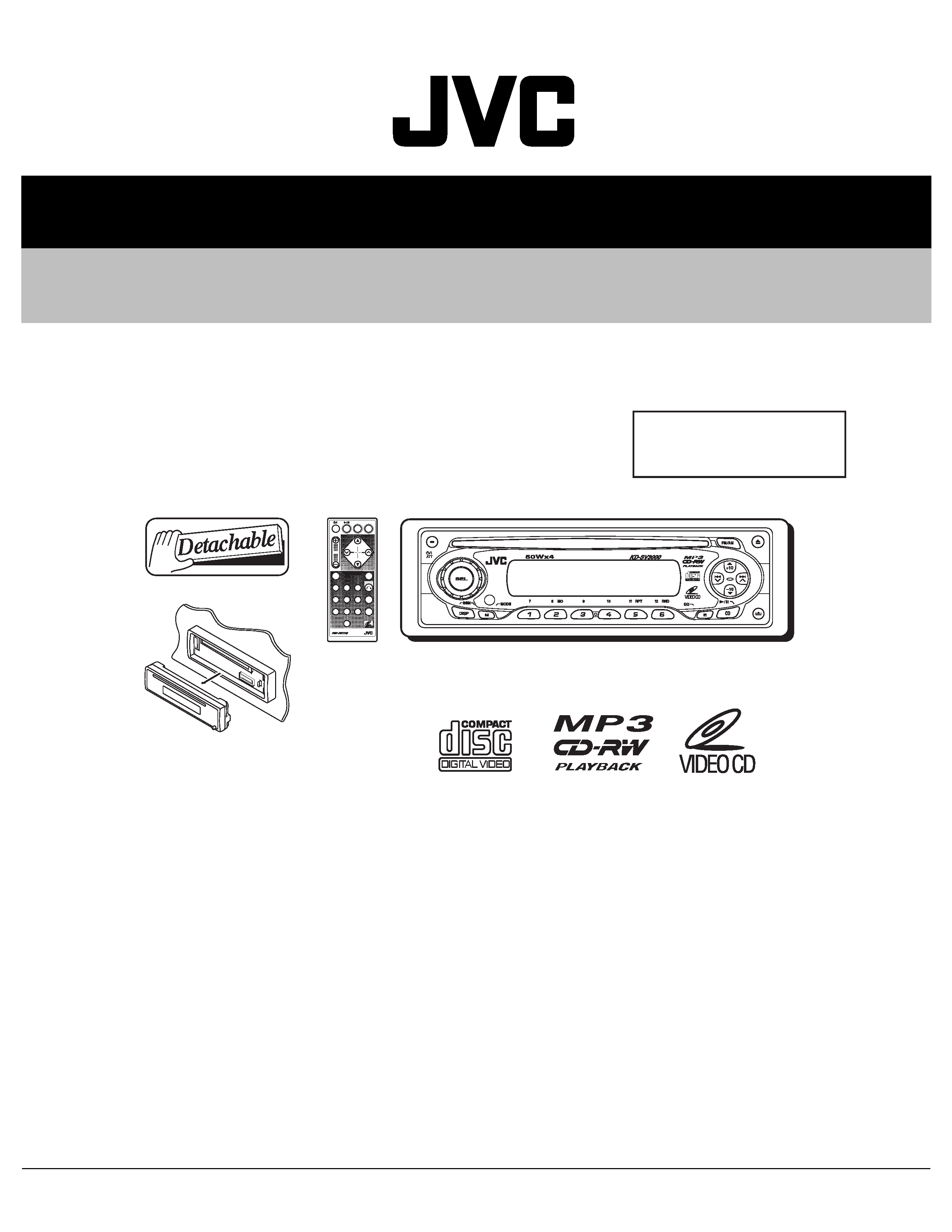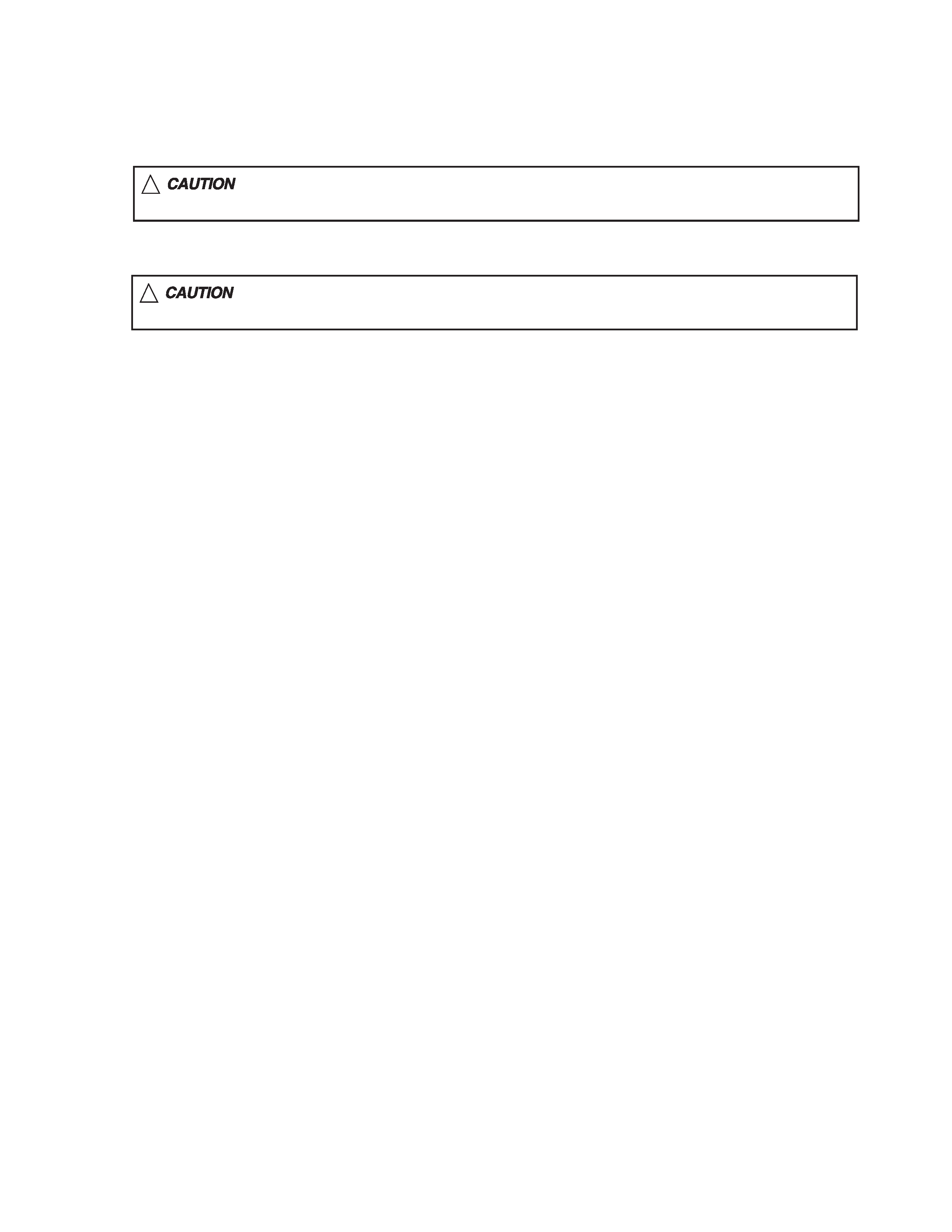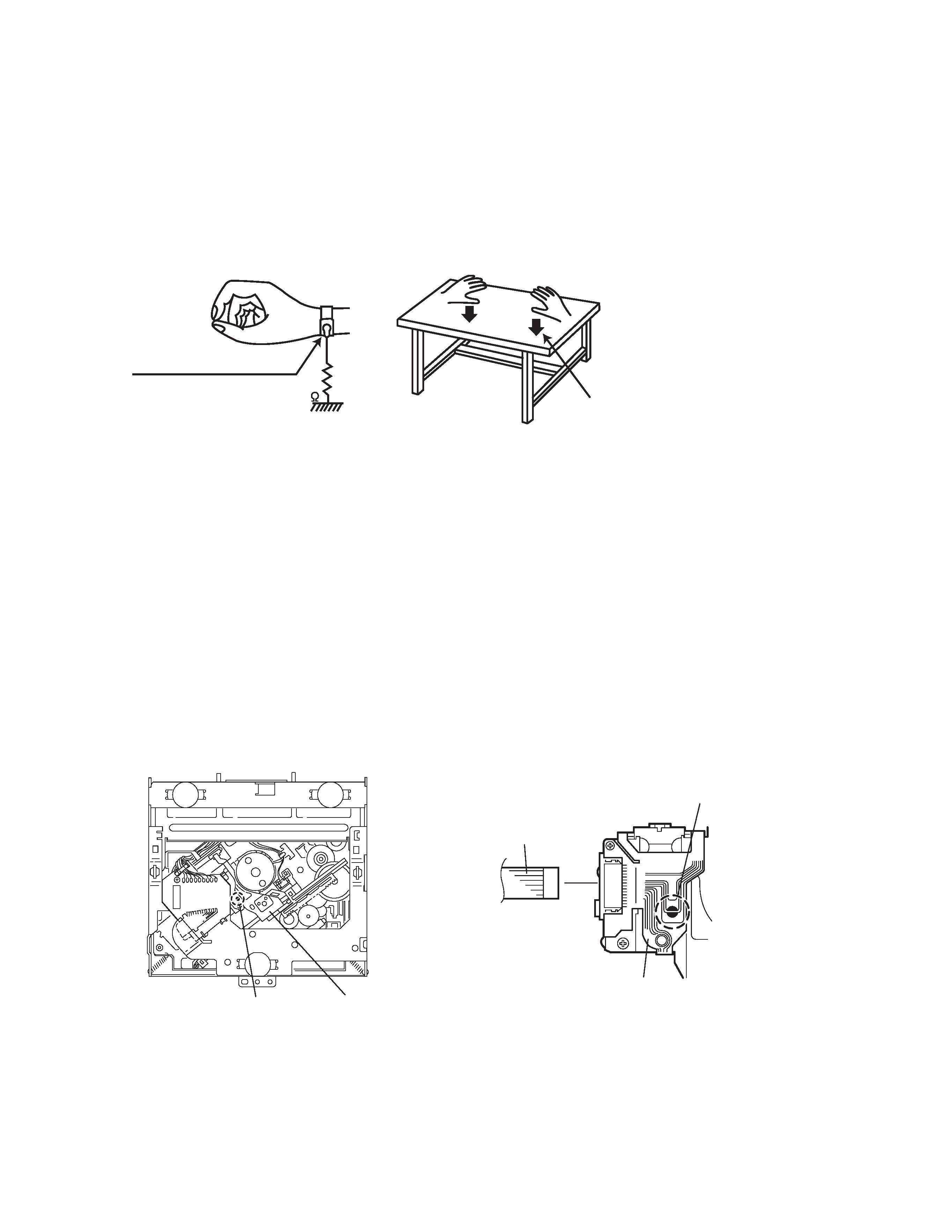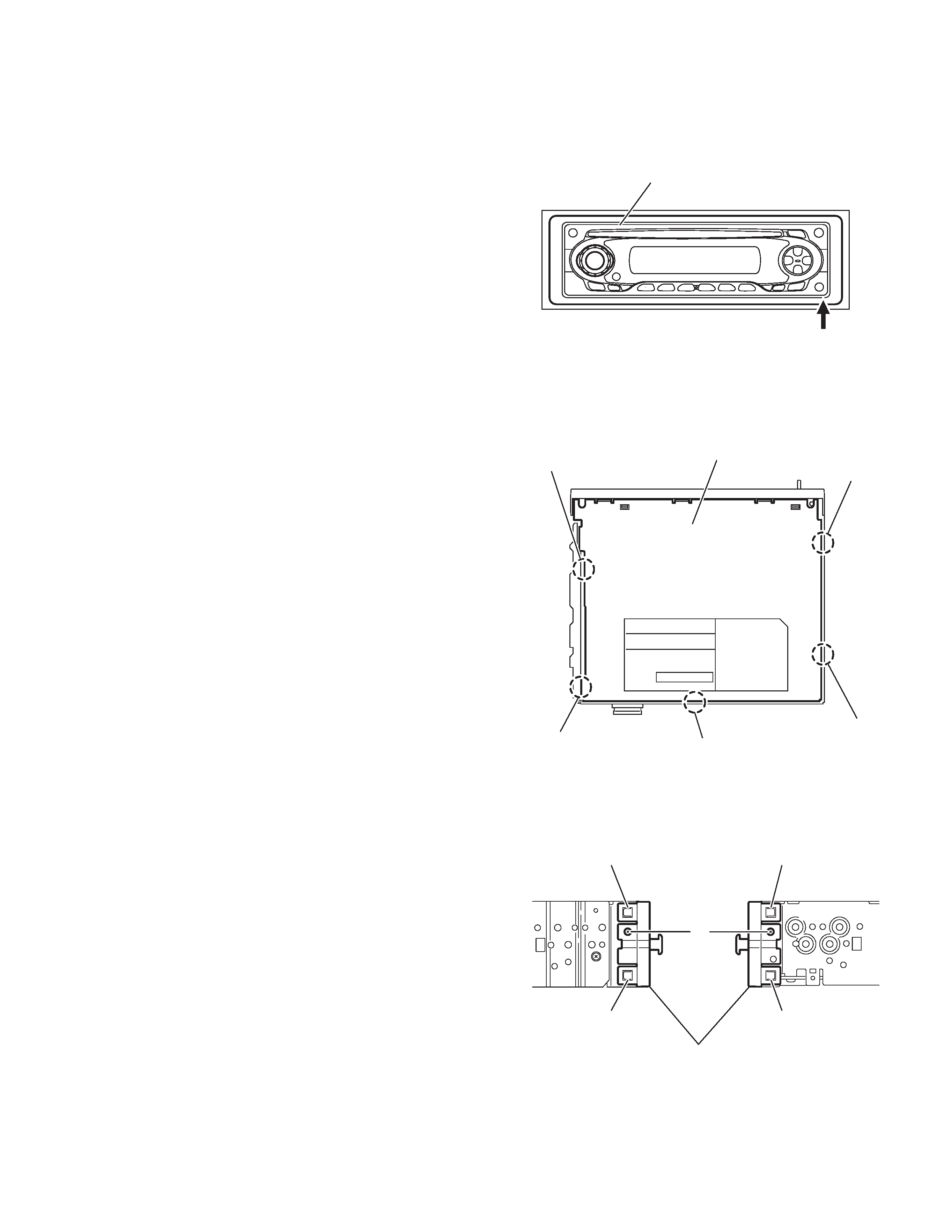
SERVICE MANUAL
COPYRIGHT © 2003 VICTOR COMPANY OF JAPAN, LIMITED
No.49837
2003/6
VCD/CD RECEIVER
49837
2003
6
KD-SV3000
TABLE OF CONTENTS
1
Precautions . . . . . . . . . . . . . . . . . . . . . . . . . . . . . . . . . . . . . . . . . . . . . . . . . . . . . . . . . . . . . . . . . . . . . . . . . . 1-3
2
Disassembly method . . . . . . . . . . . . . . . . . . . . . . . . . . . . . . . . . . . . . . . . . . . . . . . . . . . . . . . . . . . . . . . . . . 1-5
3
Adjustment. . . . . . . . . . . . . . . . . . . . . . . . . . . . . . . . . . . . . . . . . . . . . . . . . . . . . . . . . . . . . . . . . . . . . . . . . . 1-24
4
Description of major ICs . . . . . . . . . . . . . . . . . . . . . . . . . . . . . . . . . . . . . . . . . . . . . . . . . . . . . . . . . . . . . . . 1-27
Area Suffix
U --------------------- Other Areas
VIDEO CD
PBC
ENTER
CD
EQ
FM/AM
VOL
DOWN
UP
ATT
OSD
AUDIO
12
3
45
6
78
0
9
RETURN

1-2 (No.49837)
SPECIFICATION
Design and specifications are subject to change without notice.
AUDIO AMPLIFIER
SECTION
Maximum Power
Output
Front
50 W per channel
Rear
50 W per channel
Continuous Power
Output (RMS):
Front
19 W per channel into 4
40 Hz to 20 000 Hz
at no more than 0.8% total harmonic distortion.
Rear
19 W per channel into 4
40 Hz to 20 000 Hz
at no more than 0.8% total harmonic distortion.
Load Impedance
4
(4 to 8 allowance)
Tone Control Rang Bass
±10 dB at 100 Hz
Treble
±10 dB at 10 kHz
Frequency Response
40 Hz to 20 000 Hz
Signal-to-Noise Ratio
70 dB
Line-Out Level/Impedance
2.0 V/20 k
load (full scale)
Output Impedance
1 k
VIDEO SECTION
Color system
PAL/NTSC
Video output (composite)
1Vp-p/75
TUNER SECTION
Frequency Range FM
87.5 MHz to 108 MHz
AM
531 kHz to 1 602 kHz
[FM Tuner]
Usable Sensitivity
11.3 dBf (1.0
µV/75 )
50 dB Quieting Sensitivity
16.3 dBf (1.8
µV/75 )
Alternate Channel Selectivity (400 kHz) 65 dB
Frequency Response
40 Hz to 15 000 Hz
Stereo Separation
35 dB
Capture Ratio
1.5 dB
[AM Tuner]
Sensitivity
20
µV
Selectivity
35 dB
CD PLAYER SECTION Type
Compact disc player
Signal Detection System
Non-contact optical pickup (semiconductor la-
ser)
Number of channels
2 channels (stereo)
Frequency Response
5 Hz to 20 000 Hz
Dynamic Range
88 dB
Signal-to-Noise Ratio
90 dB
Wow and Flutter
Less than measurable limit
MP3 decoding format
MPEG1 Audio Layer 3
Max. Bit Rate
320 Kbps
GENERAL
Power Requirement
Operating Voltage: DC 14.4 V (11 V to 16 V al-
lowance)
Grounding System
Negative ground
Allowable Operating Temperature
0ºC to +40ºC
Dimensions
(W
× H × D)
Installation Size (approx.)
182 mm
× 52 mm × 150 mm
Panel Size (approx.)
188 mm
× 58 mm × 11 mm
Mass (approx.)
1.3 kg (excluding accessories)

(No.49837)1-3
SECTION 1
Precautions
1.1
Safety Precautions
!
Burrs formed during molding may be left over on some parts of the chassis. Therefore,
pay attention to such burrs in the case of preforming repair of this system.
!
Please use enough caution not to see the beam directly or touch it in case of an
adjustment or operation check.

1-4 (No.49837)
1.2
Preventing static electricity
Electrostatic discharge (ESD), which occurs when static electricity stored in the body, fabric, etc. is discharged, can destroy the laser
diode in the traverse unit (optical pickup). Take care to prevent this when performing repairs.
1.2.1
Grounding to prevent damage by static electricity
Static electricity in the work area can destroy the optical pickup (laser diode) in devices such as CD players.
Be careful to use proper grounding in the area where repairs are being performed.
(1) Ground the workbench
Ground the workbench by laying conductive material (such as a conductive sheet) or an iron plate over it before placing the
traverse unit (optical pickup) on it.
(2) Ground yourself
Use an anti-static wrist strap to release any static electricity built up in your body.
(3) Handling the optical pickup
· In order to maintain quality during transport and before installation, both sides of the laser diode on the replacement optical
pickup are shorted. After replacement, return the shorted parts to their original condition.
(Refer to the text.)
· Do not use a tester to check the condition of the laser diode in the optical pickup. The tester's internal power source can easily
destroy the laser diode.
1.3
Handling the traverse unit (optical pickup)
(1) Do not subject the traverse unit (optical pickup) to strong shocks, as it is a sensitive, complex unit.
(2) Cut off the shorted part of the flexible cable using nippers, etc. after replacing the optical pickup. For specific details, refer to the
replacement procedure in the text. Remove the anti-static pin when replacing the traverse unit. Be careful not to take too long a
time when attaching it to the connector.
(3) Handle the flexible cable carefully as it may break when subjected to strong force.
(4) It is not possible to adjust the semi-fixed resistor that adjusts the laser power. Do not turn it.
1.4
Attention when traverse unit is decomposed
*Please refer to "Disassembly method" in the text for the CD pickup unit.
· Apply solder to the short land before the flexible wire is disconnected from the connector on the CD pickup unit.
(If the flexible wire is disconnected without applying solder, the CD pickup may be destroyed by static electricity.)
· In the assembly, be sure to remove solder from the short land after connecting the flexible wire.
1M
(caption)
Anti-static wrist strap
Conductive material
(conductive sheet) or iron plate
Pickup
Short-circuit point
(Soldering)
Flexible wire
Pickup
Short-circuit point

(No.49837)1-5
SECTION 2
Disassembly method
2.1
Main body
2.1.1 Removing the front panel assembly
(See Fig.1)
(1) Push the release button in the lower right part of the front
panel assembly and remove the front panel assembly.
Fig.1
2.1.2 Removing the bottom cover
(See Fig.2)
(1) Turn the main body up side down.
(2) Insert a screwdriver under the joints to release the two
joints a on the left side, two joints b on the right side and
joint c on the back side of the main body, then remove the
bottom cover from the main body.
CAUTION:
When releasing the joints using a screwdriver, do not damage
the main board.
Fig.2
2.1.3 Removing the front chassis assembly
(See Fig.3)
· Prior to performing the following procedures, remove the front
panel assembly and bottom cover.
(1) Remove the screw A on the both sides of the main body.
(2) Release the two joints d and two joints e on the both sides
of the main body, then remove the front chassis assembly
toward the front.
Fig.3
Front panel assembly
Release button
Bottom cover
Joint b
Joint b
Joint c
Joint a
Joint a
Joint d
Front chassis
A
Joint e
Joint d
Joint e
